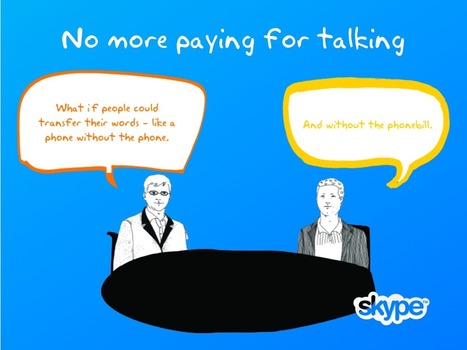 Your new post is loading...
 Your new post is loading...

|
Scooped by
nrip
|
1. Stand up for yourself, because no-one else will
2. Stepping up can be tough but it's worth it
3. Don’t let them see they’ve got to you
4. It’s hard to be first ...
5. Always retain a sense of humour
6. Anyone can be a critic - but it takes skill to be a leader
7. What other people say about you isn’t important
8. Be yourself, no matter where
9. Don’t feed the trolls
10. You say it best when you say nothing at all

|
Scooped by
nrip
|
When we think about data science, we think of a mythical laboratory where scientists are feverishly crunching numbers to provide a clear quantitative view of the future. We’ve been sold on the idea that these transformative findings will unlock increased performance numbers.
Large companies hire teams of academics to sift through their massive repositories of data, believing in data science as it is currently described: academics doing glorified business intelligence.
Startups and small businesses must take a drastically different approach if they want to see real value.
For startups, data science should not be seen as a separate scientific initiative but as an integrated part of the product. Speed and efficiency are key factors to burgeoning companies; hiring and building out a team of data scientists, or more aptly named “data product engineers,” is paramount. Once you accept that data science is about building data products, you will see that your data engineers, contrary to popular belief, do not need PhDs. Instead, they need to be able to integrate into the core of your product and engineering organization.
How do companies build out data product teams that are nimble enough to create such products? We approach the entire data science hiring paradigm differently.
Most current (traditional) job postings are looking for individuals with Ph.D. and industrial research experience, but most startups don’t need bleeding-edge machine learning to drive substantial business success. Therefore, advanced academic credentials are not the right criteria to look for when hiring someone to build great data products for your startup. Someone who only feels comfortable writing non-production code in Hive, SQL, R and Matlab can’t build great data products. This creates a data science organization that works in a dark corner and throws algorithms over the fence hoping the engineers can implement them in the product.
What you really need is someone who understands how to take data and transform it into a product.

|
Scooped by
nrip
|
The principles of the lean startup movement are fantastic: companies should remain small and and validate their market and product as quickly and efficiently as possible.
There are many companies who execute this strategy flawlessly and reap the rewards.
There are also companies that hide behind lean startup philosophy to justify a directionless effort to build a company. Stated plainly, these companies don't have an idea, but test concepts in hopes of landing on something real.
Many people fail to realize that the lean startup movement is still dependent upon VISION.
A company with vision knows their space and has identified an opportunity. They test the opportunity they've identified [the problem] and are able to formulate a solution [their product] based on their interpretation of people's feedback against their domain knowledge [vision]. When their early assumptions are correct, the company only needs to make small corrections to reach their destination. When they're wrong, the company many need to pivot.
A successful pivot is still often directed toward the same broad market opportunity or customer segment -- it's just a change in strategy to reach a similar goal. Someone experienced in the field might say, there's an opportunity in social CRM and I think people need a desktop solution.
They may subsequently learn that the correct solution is always on hand and should be mobile based, so they pivot. This is like Columbus heading out to the new world and at least knowing it was "that a way."
A company without vision starts from a place of ignorance and is unable to respond to feedback as it arises. Even if their problem plus solution is only off by a few degrees, they may misinterpret the feedback and pivot wildly. From a distance, these companies are easy to spot because they thrash from idea to idea.
So, you're a prospective startup founder and you've read everything about the lean startup movement. Should you start a company? No, not if you don't understand a market and at least see a broad market opportunity. Lean startup methodologies are just a set of tools to help you achieve your vision.
How do you gain vision? Work in the field or look to your own interests. And if you're unwilling to do that because you just have to start your company now, at least do some serious research before taking any money. Money comes with expectations. When your half-baked idea fails, you'll be forced to come up with something else... which is how you end up pivoting and working on something stupid for several years of your life.
Do yourself a favor, develop some vision before you start your company.

|
Scooped by
nrip
|
Devices connected to the internet — everything from coffee makers to toys — are going to become a widespread consumer phenomenon sooner than you expect, even though Europeans and Americans for now regard the technology in different ways.
Until now, smart machines connected to the internet have largely been the province of industry and governments. In the view of two executives, however, such devices will soon become ubiquitous at a consumer level, and everything from coffee machines to toys will have at least a brief life on the internet.

|
Scooped by
nrip
|
Some people seem to think that getting acquired should be the highest aspiration for an entrepreneur in Silicon Valley. I disagree vehemently.
In fact, I think that mindset does a disservice to the entrepreneurs in Silicon Valley and around the world. This is exactly the wrong way to think about building a start-up not only because it develops the wrong company culture, but on a large scale it can poison the unique and innovative ecosystem that has developed in Silicon Valley over the past 40 years. You want missionaries, not mercenaries –passionate, maniacally-focused founders who believe in a vision. Founders like this draw the most gifted and passionate employees, who maximize the chance of success, even if they ultimately fall short of their initial goals and get acquired.
There are of course mercenaries and people setting up for “acqui-hires” in the valley as well, but that is not what Silicon Valley’s special sauce is about.
In my view, it’s irreverence, foolish confidence and naivety combined with persistence, open mindedness and a continual ability to learn that created Facebook, Google, Yahoo, eBay, Microsoft, Apple, Juniper, AOL, Sun Microsystems and others.
Having a vision does not prevent you from being acquired, but starting a company to “do a deal” is not what Silicon Valley culture is about even if most companies that have a successful exit are acquired. An acquisition may be a safety net, a way to free yourself or learn to pursue another bigger or more interesting vision, but those are tools rather than goals of the true Silicon Valley entrepreneurs I have seen. (When I say Silicon Valley, I mean it how my Kleiner partner John Doerr meant it when he used to say “Silicon Valley is not a place but a state of mind.”)

|
Scooped by
nrip
|
Strategy is important. So is vision. You know where you want to take your team. You know what results you need to achieve. And you know how you intend to compete and win in your markets. Leaders love to talk strategy, vision, and meaning. What they often spend too little time on is actually teaching their people “how to.”
Get Tactical
One of the greatest minds on winning wrote, “Strategy without tactics is the slowest route to victory. Tactics without strategy is the noise before defeat.”
Your team knows what you want. They are smart. Intellectually, they understand what you want. This isn’t where they struggle. The resistance that you sense isn’t to your strategy or your vision. They’re not trying to be adversarial or obstructionist.
The reason your team isn’t doing what you need them to do is that they don’t know how. They lack the confidence that they can achieve the necessary outcomes. Mostly this is because what you are asking of them is difficult. The strategy isn’t the challenging part; it’s the putting it into practice that is the difficult part. It’s the tactics.
Tell Me How To
It’s difficult to gain appointments with the dream clients that you need to grow your business and do the meaningful work that you want to do. Most salespeople struggle with opportunity acquisition. If you want them to improve here, you have to help with the “how to.” They already know you want more and better opportunities.
It’s difficult to build consensus around a new idea. It is super challenging just to break out of the silo in which your power sponsor has caged you. If your team knew how to get out of that cage without alienating the people with whom they have relationships, they’d have already done so. They know why they’re stuck. What they don’t know is how to get unstuck.
And now you want them to capture value? If you haven’t had the pleasure of sitting across from clients defending your price for some time, you might be surprised how difficult it is to convince your dream client that there is a difference between price and cost. Oh, and don’t get me wrong here; intellectually, your dream client understands. It’s getting them to agree to make the larger investment instead of demanding a discount that’s the challenging part.
There is power and confidence in knowing how.

|
Scooped by
nrip
|
I recently came across an article on Harvard Business Review that I found challenging and applicable to any of us leading teams. The author presents twelve statements that good bosses believe.
1. I do not fully understand what it’s like to work for me. It is important for us to recognize that our personal view of how we lead and the reality of how we actually lead are different. Recognizing this difference can help us treat those who work for us with humility as well as offer us the opportunity to improve our leadership by checking in with our employees and team members to clarify what has been communicated knowingly and unknowingly.
2. Having ambitious and well-defined goals is important, but it is useless to think about them much. My job is to focus on the small wins that enable my people to make a little progress every day. This may seem like an odd statement to include when we talk extensively about the importance of establishing a specific mission, vision, and goals. They should be thoughtfully established and serve as the guide for all projects, but if you’re constantly readjusting them or measuring your team on a huge, overarching vision on a daily basis, then your team will never feel successful and become defeated easily. Celebrate small wins with your team along the way to achieving the bigger goals to inspire your staff.
3. One of the best tests of my leadership — and my organization — is "what happens after people make a mistake?" Innovation is healthy but can only happen if people are allowed to try new things and maybe even fail. Rick Warren recently tweeted, “You must be willing to fail a lot to learn what works. At Saddleback we've tried more things that didn't work than did.” Innovation doesn’t happen in an environment where people are scared to fail. It only happens when they feel free to try new things and express their creativity.
What happens on your staff when someone makes a mistake? Are they criticized in front of the group or do you approach them one-on-one to understand their reasoning for making the decision? Think deeply about your response to this question and about the message you’re communicating to your staff when an employee makes a mistake.
4. My job is to serve as a human shield, to protect my people from external intrusions, distractions, and idiocy of every stripe — and to avoid imposing my own idiocy on them as well. In a church setting, this cannot be overstated. If you are intentional about implementing your mission and vision, you will encounter “trials of every kind.” You set the precedent for your employees as to how they respond to questions, conflict, and stress. How are you setting them up for success by equipping your team to respond well to hardship?
5. How I do things is as important as what I do. I was a summer “Work Crew” at Young Life’s Frontier Ranch back in the summer of 2000. One of the first things we were asked to do was to pick up every piece of trash we saw, at any time. The leadership cared about creating a distraction free and beautiful experience for campers. A few weeks into my month, I watched as the property manager, without knowing I was watching, went out of his way to pick up a small candy wrapper. I didn’t need to be asked to pick up trash again

|
Scooped by
nrip
|
Maybe you are just thinking of starting a business. Or perhaps you have already begun, but are quickly realizing you can’t do everything yourself. If either of these scenarios sounds familiar, I’d like to share with you a great approach I’ve discovered for soliciting honest opinions without stepping on any toes — and learning which weaknesses I need to address, stat.
Only the Strong Survive
Getting to know your strengths and weaknesses is easier said than done. Many of us think we’re great at certain things, whereas others would perceive us as being “C” or “D” students at best. So how do you get an accurate picture of your strengths and weaknesses, and why does it matter?
Accuracy in perception is important. Knowing where you excel will guide you through your goal-making process, and knowing where you are weak will steer you towards the right moments to ask for help. Plus, if you know where you are weak, you can also figure out where your money will help you the most. For example, hire an accountant or bookkeeper if you’re not great with numbers. Hire a writer if the world of words doesn’t tickle your fancy. This method can even be applied to choosing a partner or team members, both which are very important aspects of the business-planning process.
How to Conduct a “No Blame” Survey
Start your self-assessment by making a simple list of every business skill you can think you have. Then, add other skills that you think make a good leader/business owner. Add any additional questions you think would be helpful.
To get you started, these are a few questions I ask my team to answer at the end of individual projects:
- Did I make you feel comfortable about making your own decisions pertaining to the tasks you were responsible for throughout the project?
- What could I have done on this project to be a better leader?
- What did you most appreciate about me as a leader throughout this project?
- What’s one thing you think we could do differently as a team on the next project?
Now ask as many people as you dare to rate you in the same way through an anonymous survey. You can do this using an online surveying tool like SurveyMonkey, or use Forms i Google Drive.
Tell people not to put their name on it. This way, you won’t be offended by anyone’s opinion and they will feel safe to tell the whole truth. I’ll never forget a programmer’s expression when I asked him to fill out an anonymous survey about me so I could improve on my leadership and management skills. He laughed out loud and said, “Wow, you take this personal development stuff very seriously!” I do, and you should too. Do not open any of the surveys until you’ve collected at least 10, and only ask people that know you or have worked with you directly.

|
Scooped by
nrip
|
Teams are great for accomplishing projects or complex operations / tasks. High performing teams can get more done more quickly than any one person. However, keeping teams on task and on track can be a real challenge. Even great teams can get distracted or pulled in the wrong direction. So how do you keep your team’s productivity up?
Here are 6 secrets to team productivity:
Have fun. When people enjoy what they do and the people they are doing it with productivity will increase. Find small ways to break tension and stress by having some fun. Laugh at yourself in a team meeting, take a lunch break together that is different than normal (go out or bring in picnic foods, whatever works), create funny rewards for participation or ideas, or something else that will bring humor to the team without poking fun at anyone else. A couple of minute laugh break can get a meeting or work session back on track faster than pushing through it.
Allow personal space. Working closely together can become suffocating at times. Create a way for people to step away and work independently for a while. Unwinding and working alone can make coming back together to share results and progress more rewarding. People need quiet time.
Keep updates short. While reviewing individual updates, limit the time people can spend sharing their reports. Making sure this portion moves fast helps build a sense of momentum and eliminates boredom while others drag on. Use a template if needed, drive the discussion of tasks and hold people to the agenda.
Avoid the blame game. Things will go wrong at times, instead of looking for people to blame focus on moving forward. If people are worried about getting in trouble for an error they are not working on needed tasks or assignments. Make it okay to make mistakes as long as people own their actions and bring solutions with them. Always be looking towards the finish line.
Pick 3 things. Too often departments or teams have too many goals to focus on at any one time. Pick the top 3 or 5 things you need to do this week/month. Get these in the spot light and work towards them. When they are done move on to the next items. As the leader you need to set priorities for your team and help them know what is critical right now. Limit the number of critical items so they can be accomplished.
Believe. If you believe your team can reach or exceed their goals and you communicate that often they will believe it. Holding people accountable is important but holding people capable is empowering. Show them that you trust them to get it done and they will surprise you with their results.

|
Scooped by
nrip
|
While push and in-app notifications may be tempting, mobile marketers shouldn't forget good ol' email.
When thinking of mobile, email is probably not the first thing that comes to mind.
A technology first popularized in the 1990s, it still carries strong associations with the desktop and web experience. Even on platforms like Blackberry, which first introduced the concept of mobile email, the messaging format has lost its luster. Today, marketers are much more excited about app-centric messaging and mobile-first apps like Snapchat and WhatsApp.
Despite its lack of novelty, email is still massively effective. Just two years ago, email open rates were a healthy 23 percent, and email advertising commanded one of the highest CPMs (cost per mille) of all ad formats. But as smartphones, tablets and other mobile devices explode in popularity, the landscape has shifted dramatically.
This year, email open rates have surged to 31 percent. As more people access email on the go, there is a higher probability that marketers will reach them. But even more impressive is that 44 percent of all emails are now accessed on mobile, compared to 11 percent in 2011. That number is projected to cross the 50 percent mark by the end of the year. Consider mobile usage patterns It’s a well-known fact that the best time for mobile engagement is in the evening. Research the times that work best for your audience, as there may be a significant difference between mobile and desktop behaviors.
As email shifts to a mobile-first experience, marketers should think about the channel not as a dusty old technology, but as their secret weapon. Email today is much more effective than it was a few years ago, and it carries several strategic benefits for the small screen. It only takes a few small steps to get started. Marketers who embrace these changes — which can be as small as optimizing an email’s length — will gain an important advantage over their less-savvy competitors.

|
Scooped by
nrip
|
Entrepreneurship is a game that you win in the long term. It is a game that is beyond just you. It is a myth to think that you alone will have it all under control, however smart you are.
If you are a first-time entrepreneur in any industry, odds are well against you. You already know this, too, but you go ahead with your (ad)venture. Hats off to your courage, but that’s not sufficient enough to cross all the hurdles.
1. Not being able to see escalating friction There is literally zero friction for your ideas when they are in your head. The friction escalates at an alarming rate as you move through the following phases: * Reflecting on your idea and self-validating * Asking people close to you, not necessarily those that are knowledgeable * Sharing it with people who think similarly to you * Market research * Recruiting partners whom you will pay (vendors of any kind) * Talking to potential prospects * Talking to potential investors If you don’t understand the level of friction at each stage, you will notice that you will enter the stage terribly unprepared and fail miserably.
2. Confusing activity with progress In a startup, there are so many things to do and so many things that you can do. Lot of activity can happen under the radar without ever talking to a potential customer. Interestingly, you can create work that will create more work. For instance, you decide to file for not one but five patents. That will spawn some work. This work will spawn more work in terms of queries from USPTO, and those queries will spawn some more work. The sad part is that you can start misattributing several activities to progress. In general, any activity that cannot create value to your customers in a measurable way needs to be questioned. There is a good chance that it’s just activity leading nowhere.
3. Lack of valuable accomplishments Unless you have built a product that is shockingly awesome, you need to have built an identity that will bring credibility to the venture. Somebody should be able to easily understand and appreciate why you are the right person to take this venture forward. If they don’t believe in you, the derivative will be that they will lose belief in the venture. People do judge a book by its cover and a founder by his or her previous valuable accomplishments. You might as well get prepared for it.
4. Not knowing what not to do Time is the most precious asset you have. It is not only important for you to know what to do but most important to know what not to do. How do you get to know that? It comes from experience. But you are a first-time entrepreneur, so experience is out of the question. This is where you surround yourself with people who have been there and done that and are willing to help.
5. Concluding for convenience It is better to call a spade a spade and move on. When you take a misstep or face a setback, it is better to quickly acknowledge that you goofed up and clear the air for the next set of actions. When you engage in blame game to conveniently wiggle out of the uncomfortable situations, nobody wins. If you are surrounded by smart people, they will see through it; and if you are not surrounded by smart people, you have a bigger problem at hand already. By design your first foray into entrepreneurship will be uncomfortable, and that is part of growth. By posturing as anyone other than a student of the craft, you will be doing a dis-service to yourself and others around you.
6. Trying to fix your weaknesses fast Trying to fix your weaknesses during your first entrepreneurship journey will be like trying to change tires on a moving vehicle. There is no trial run in entrepreneurship; everything is real. The only way to win the game is to play to your strengths, invest in your strengths, and invest in the team that will compensate your for your weaknesses.
7. Believing that you will have it all in control There is a thin line between confidence and hubris. Your hubris might appear to you as extreme confidence until you are humbled. There is an African saying that is apt in this and many scenarios. It goes something like this: “If you want to go fast, go alone. If you want to go far, go together.” Entrepreneurship is a game that you win in the long term. It is a game that is beyond just you. It is a myth to think that you alone will have it all under control, however smart you are. As you would have guessed, there are many more hurdles along the way. Whatever your adventure, it will be a humbling experience that will help you grow by leaps and bounds along the way.

|
Scooped by
nrip
|
The news — finally made official — that Spanish soccer club Real Madrid has lured Welsh player Gareth Bale away from English team Tottenham Hotspur for a world-record transfer fee of $132 million (or €100 million) has had the soccer industry on edge for weeks.
Even before the deal was confirmed, insiders rushed to condemn it. Arsenal manager Arsène Wenger referred to the staggering sum as "a joke," while new FC Barcelona coach Gerardo Martino upped the ante by saying the planned transfer showed “a lack of respect to the world in general.”
It does seem crazy to spend such a vast amount of money on one player, especially in a decidedly weak Spanish economy where unemployment is sky high and where many businesses — including Real Madrid, and indeed the majority of Spanish soccer clubs — face high levels of debt. And to offer Bale a salary of hundreds of thousands of dollars a week when so many people struggle to make ends meet seems downright absurd.
Yet the Gareth Bale transfer is only the latest in a string of big signings this summer. In his eagerness to criticize Barcelona's arch rival, Martino might have overlooked the fact that his own club is among the heaviest spenders in the world of football year after year. This summer, the club paid a reported $67 million for Brazilian star forward Neymar, while selling another player, David Villa, for $7 million only three years after having paid over $50 million for him.
And that's just one club: I could list dozens of other examples at clubs such as Manchester City, Chelsea, Paris Saint German, and Monaco. Knowing the money for Bale was on its way, Tottenham Hotspur itself has been a big spender, too.
And whether we like it or not, the soccer industry is far from the only sector of the economy that is turning into a so-called "winner-take-all market" in which the few who have risen to the top of their profession (think of professional athletes, best-selling authors and Grammy-winning pop singers, but also Fortune 500 executives, salespeople, and investment bankers) can earn extremely high fees while a much larger group of also-rans in these sectors barely earn a living.

|
Scooped by
nrip
|
No one said building a company was easy. But it's time to be honest about how brutal it really is--and the price so many founders secretly pay.
Successful entrepreneurs achieve hero status in our culture. We idolize the Mark Zuckerbergs and the Elon Musks. And we celebrate the blazingly fast growth of the Inc. 500 companies. But many of those entrepreneurs, like Smith, harbor secret demons: Before they made it big, they struggled through moments of near-debilitating anxiety and despair--times when it seemed everything might crumble. Lately, more entrepreneurs have begun speaking out about their internal struggles in an attempt to combat the stigma on depression and anxiety that makes it hard for sufferers to seek help. In a deeply personal post called "When Death Feels Like a Good Option," Ben Huh, the CEO of the Cheezburger Network humor websites, wrote about his suicidal thoughts following a failed start-up in 2001. Sean Percival, a former MySpace vice president and co-founder of the children's clothing start-up Wittlebee, penned a piece called "When It's Not All Good, Ask for Help" on his website. "I was to the edge and back a few times this past year with my business and own depression," he wrote. "If you're about to lose it, please contact me." Entrepreneurs often juggle many roles and face countless setbacks--lost customers, disputes with partners, increased competition, staffing problems--all while struggling to make payroll. "There are traumatic events all the way along the line," says psychiatrist and former entrepreneur Michael A. Freeman, who is researching mental health and entrepreneurship.
|

|
Scooped by
nrip
|
These are lessons that come not from reading around, but straight from personal experience. I thought I’d share the current state of the list, together with some elaboration on the background for each point.
1. My mother used to say – “Every problem has at least three solutions. Keep looking until you find all of them.” That was her usual way of setting the bar an order of magnitude harder than normal people and it taught me the fact that any problem was surmountable, that I should always keep looking for new options, and I should always set expectations way higher than is reasonable.
2. You should spend at least as long studying the concept of learning itself, as you do on any topic that you actually learn. I read some great books like The Art of Learning, and applied all of the principles when I went back to Cambridge. It showed me that you can genuinely learn anything, and quickly, as long as you are willing to have the dedication and apply yourself to the process in the right way. I’ve since seen others around me pick up that vibe, and learn some amazing skills in ridiculously short timeframes.
3. “You will get all you want in life if you help enough other people get what they want” – Zig Ziglar. You can always trust an American motivational speaker to come up with something cheesy, but I have to say this is the one main principle I live my life by. The UK is a comfortable country to live in – most of us have the luxury of spare time outside of necessary work. If we spend that time helping people get what they want, it will always come back to us. I find it very difficult to connect with people who don’t share this attitude.
4. The people around you determine who you are. My life has had a lot of ups and downs.. In 30 years I’ve lived through enough for a lifetime. As I look back now, the fluctuations can so clearly be attributed to the people I was surrounding myself by. So choose role models, and see what they do. Then do the same. Go to those places, take up those activities, meet those kinds of people, and only ever surround yourself by people who you want to be like. Create your own environment and ecosystem – don’t just fall into whatever is there.
5. Never eat alone. That was my last blog post, so I won’t rehash the point in detail. In order to create that perfect ecosystem, you have to meet the right people. The day is for working, so the only time to do this is during meal times. Get into a routine of eating with 2 or 3 new people a day and watch your social circle flourish.
Read the rest at : http://www.ivanmazour.com/the-10-most-instrumental-lessons-in-shaping-my-life-and-success/

|
Scooped by
nrip
|
Here are five key points to increasing your influence in support of your strategies.
1. Produce quality content
If you want to make your mark on social media, you should provide quality content. Generate your own, become a thought leader, and share other people’s content that you believe is interesting.
2. Be open and engaging
On social media, it’s important to be available to your audience, and few people exemplify that principle better than US entrepreneur Gary Vaynerchuk. For example, on Twitter he does a lot of responding to followers. He treats everybody as an equal, and responds at an amazing velocity.
3. Focus on a specific nicheOn social media, you can either be a generalist – producing and curating a hodge-podge of content across many different disciplines – or you can choose to specialise in one or a few areas. Specialists tend to bend more ears than generalists.
Social media is extremely noisy. You’ve got to be able to stand out, and the best way to do this is to own a particular subject.
4. Use social media to build your business, and vice versaFor an entrepreneur, time spent on social media might seem like a distraction from the more important tasks central to running a business. Because it’s so time-intensive, back up your thought leadership on social media with a profit-making enterprise.
5. Embrace each social network’s unique cultureEach social network has a unique culture, and the best users embrace it rather than sharing identical content across platforms. Take Cory Booker, the mayor of Newark, New Jersey. He relies mainly on Twitter, where he has more than 1,2 million followers – and Facebook, and uses each platform in a way that takes advantage of its native capabilities.

|
Scooped by
nrip
|
There are many fine values, such as courtesy, confidence, ingenuity, thrift, and so on. The trouble is that the list of values grows easily and can cause many employees to lose their focus. They fail to prioritize. A “short list” of values is far more useful in putting the workplace back on track.
Moreover, when the core values exceed four or five points, it becomes difficult to communicate and reinforce them. The following are five candidates for the practical values having foremost importance:
- Integrity
- Accountability
- Diligence
- Perseverance
- Discipline
I know companies — strong organizations — centered on these values. They are invariably successful. Almost always, these core values generate other values in employees.
But what if all our organizations started with the same short list?

|
Scooped by
nrip
|
Progressive organizations and their HR people spend a lot of time trying to figure out how to attract "the best" employees.
Here's the secret: you can't.
I've been in HR circles long enough to know that perfect people don't exist. Despite anything you've heard about the algorithm for the optimal hire, such an employee is fiction. The not-so-secret reality is that there's no such thing as the "best" talent. There are only good people who have the potential to become great employees. It's your job to help them deliver.

|
Scooped by
nrip
|
It used to be that entrepreneurs were the renegade cowboys out in Silicon Valley. Nowadays, you have to be an entrepreneur just to get and hold a job.
Consultants and freelancers are cheaper than full-time staffers with benefits, software developers overseas cost a fraction of what they cost in the U.S. and, by 2030, robots will be able to perform most manual labor, according to an infographic (below) from San Francisco-based startup organization Funders and Founders. Even employees who are employed in large corporations are encouraged to be “intrapreneurs,” meaning that they are in many cases given company time to come up with disruptive ways of thinking about corporate organization and practices.
No matter what your office looks like, you are going to have to become an entrepreneur. Take a look at the infographic to understand why.

|
Scooped by
nrip
|
Damn, entrepreneuring is hard. And fun. And personally rewarding if you can handle the responsibility of being a leader.
For me, the most rewarding aspects of being an entrepreneur are the serious challenges that it presents and the no-safety-rope, feet-to-the-fire doing that's required. Leadership is one of those executive skills that are absolutely critical for success, but it isn't really taught in the schoolroom - most of us have to learn it through a variety of costly trials and errors, and very patient mentors. Despite little training, poor leadership is often the reason for failed businesses and stalled careers, the kind of thing we all try to avoid.
Leadership is difficult for everyone. That's why the world has so few good leaders. When you get right down to it, the difficulty with leadership is the people part of it. "People" are that magic and the complex society whose inner-workings will either make or break your machine. So that's a real place to focus on, right? Without a conscious effort and the ability to learn from your mistakes - and I've made mistakes! - it's difficult to develop the ability to effectively lead any group of people, much less a diverse group.
1. Take the First Step.
What is leadership without action? When hiking, the First Step might be literally the first step down the path. In a boardroom, the First Step might be taking responsibility when others pass, or making a difficult decision and letting others know how it affects them. Strive for action when others stall. Don't be afraid to make those difficult decisions and move forward. Use your inertia to show your team how and when to take action.
2. Come From a Positive Place.
People know... They can smell it. Bad intentions are poisonous, so be double extra sure to come from a place of good intentions, no mater what the circumstance. Pause, think and make sure that what you are saying and doing comes from that positive place, and make it obvious before you take any actions that affect people.
This doesn't mean avoiding difficult situations (welcome those) or being disagreeable (that's necessary sometimes). It means that the actions that you do take should obviously support your goals and your team's goals. Success comes easier this way. Who wants to follow a bad apple?
3. Be Consistent.
Consistency develops organizational trust. When actions are, or even seem inconsistent, those around can become confused, losing sight of what to do or how to provide support. Confusion is not a good team building emotion, it damages workflow, and creates an uncertain atmosphere. Take note of your own personal patterns because those around you already do.
4. What Are You Being?
I resolved myself to become the kind of leader that attracts other leaders. This requires me to take actions that build trust, respect, and kinship. It also requires me to specifically think about each and every interaction that I have with recruits, my team, clients, vendors, and, well, everyone. "What are you being?" is the question that I ask myself to test whether I'm behaving in the way that supports my leadership goals. It's one of those questions that can stop you in your tracks, if you're honest about the answer.
5. Take a Step to the Side. (And Listen)
Great leaders are also great followers. How else could you know what leadership is? Be a great follower, continuously strive for improvement, and by your actions, teach everyone what that means.

|
Scooped by
nrip
|
Leading a group of people is not an easy endeavor. There are so many responsibilities, duties, and things to remember. And once you have considered all of these things, you then have to take your employees into account.
You have to consider both the way you lead them and the way you look after them.
For those of you who are concerned about your leadership skills, here are 5 questions that you should ask yourself before you can become a better leader.
5 Questions To Become a Better Leader
How Do My Employees See Me?
To be a good leader you must be seen to be a good leader. - Are you the type of leader that your employees fear?
- Do your employees scatter as you walk past?
- Do they exhibit their trust in your leadership?
If this is the case you need to interact with your employees more often and in a less formal manner. Your employees should view you not just as their manager, but as a part of the team; because that’s what a workforce should be, a team.
Am I Leading by Example?
It’s inevitable that your employees will attempt to “follow in your footsteps”, due to this you must tread carefully.You should be seen to take responsibility and work well, cutting corners and spending too much time on the phone or talking with colleagues implies that it’s okay for the staff beneath you to do the same. It would be hypocritical of you to caution your employees for doing something that they have witnessed you doing, so be the best role model that you can be.
Do I Provide my Employees with Enough Motivation?
Understanding how your employees are motivated and what you can do to motivate them further is imperative as a leader. Discover what it is that makes your employees tick and use it to help them; a motivated employee is often a productive employee.
A more productive workforce could see you with an increase in profits overall.
Methods of motivating your employees include competitions, rewards and bonuses for hard work or targets that have been met.
Am I Devoting Enough Time to Helping My Employees Progress?
There simply aren’t enough hours in the day when you are in a management position or a role where you are having to lead others.
But is this an excuse to neglect your employees?
It’s understandable that you may feel stressed due to your work but to be an effective leader you must overcome this and take some time to speak with your employees. Help your employees overcome the obstacles that they are facing in the workplace and support them where possible; if one of your employees is dealing with a difficult client take over for them and later explain to them the best approach when dealing with demanding customers.
Do I Listen to The Needs of My Employees?
If you want to maintain mutual respect between you and your employees it’s essential that you listen to any problems that they may have within the workplace. Bear in mind that not all employees will be forward enough to tell you of issues straight away, you must take the time to speak with them on a regular basis and encourage them to discuss their problems with you.
When they are telling you of their troubles it’s imperative that you don’t interrupt at any point as this can make people feel nervous which in turn makes them less likely to discuss things with you in the future.
There are several other things that you can do to improve your methods of managing and to become a better leader, one of these would be to speak to your boss and ask them how they have achieved their position within the company and how it affected their leadership skills.

|
Scooped by
nrip
|
*Skip graduate school and get an “experience MBA.” We are the first generation that has access to extreme self-education, which means that traditional degrees are often irrelevant and sometimes financially crippling. As a generation, it’s time to rethink our trillion-dollar education debt.
*Hone a powerful network. One that can generate world changing energy. Netflix NFLX +0.92% improved its film recommendation algorithm by crowdsourcing code writing, KIVA generated hundreds of millions of dollars in microloans and re-architected the traditional system of bank lending as a route to network fundamental and massive change and we all have access to the same powerful tools they used.
*Approach traditional spaces from unique angles. Yes, thinking “outside-the-box” creates a competitive advantage. Always. Blake Mycoskie wasn’t a shoemaker or a force in global health and education until he decided to be one. Join the Renaissance and reinvent the world, as you reinvent yourself.
* Keep your venture tethered to social good and positive culture. Companies today are engaging in philanthrocapitalistic ventures in record numbers, and in unique ways. Ventures that tie every day consumption to harness our collective consumer dollars to affect positive change. This not only does good, it feels good.
*Employ a multidisciplinary approach to everything as you explore markets in new and unique ways. What does micro-finance in Kenya have to do with your company culture and ultimate profit? What can a computer scientist learn from a social psychologist or an environmentalist learn from an artist? What can the world learn from you?
*Time, knowledge and participation in each other’s stories are all viable forms of currency, and the most valuable currency is not necessarily “green.” Nor is the most valuable solution already written, or dollar driven. KIVA taught us that those simple human stories and personal connections can be powerful vectors for change.
*Harness capitalism for good by incorporating giving into everything that you do. What you buy, what you wear, what you eat, and where and how you work, can be both a significant global force and self-defining.
* Exploit low-risk, high-reward opportunities. This mitigates risk and allows room for explosive, rapid-fire success. Today a company can be started for next to nothing and an education secured with the touch of our fingers. We all have the chance to create and exploit derivative success markets for ourselves. Right now.

|
Scooped by
nrip
|
Is your leadership style creating leaders or just encouraging followers? Here are some tips on how to encourage your employees to live up to their potential.
When you treat a leader as a follower, you are turning them into someone who does not develop the necessary independence, strength, and personal accountability for them to lead others. There is a difference between leading people through someone and leading someone who is leading others. In order to lead someone who is leading others, you need to give them these four things:
1) Territory and clear borders--Strong leaders need to have clarity about what space is theirs to command with little interference. Because you are building a team of leaders, you will have to create borders to avoid conflict when the areas of command intersect. Border skirmishes will inevitably happen and it will be your job to sort out what the leaders can't sort out on their own.
2) Objectives bigger than their own performance--Leaders need mountains to climb that are bigger than what they can accomplish on their own. This gives them motivation to engage people, set direction themselves, and push for achievement. If the goal is the size of their own talent and personal effort, you are treating them like a follower and you risk them shrinking to that size.
3) Due dates faster than what is reasonable--Any weight-lifter will tell you that if you want to get stronger, you have to lift increasingly heavy weights to the point of exhaustion. Building strong leaders means challenging them to accomplish goals faster than what others believe is possible. Time is unyielding and therefore requires creativity, diligence, perseverance, and leadership to accomplish the goals when other elements are in flux.
4) Stair-stepping their development--Leaders in development grow through increasing their challenges in all of the three items above. If you want to lead leaders, you need to regularly increase their capability through challenges, not coaching. Leaders like coaching when they ask for it. Followers like coaching all the time. Be unyielding on accountability, laser-like in clarity, and accessible to coach when requested. My client had made the fundamental mistake of hiring leaders and then tried to lead through them, rather than building them as leaders. The result is that several years later he is more tired, the business is only bigger because of his efforts, and his team is paralyzed without his daily direction of what they should do next. It is not a good position to be in.

|
Scooped by
nrip
|
Video-conferencing is a massively turbulent space right now. Large incumbents like WebEx and GoToMeeting are fighting smaller, nimbler, and cheaper options like Blue Jeans Network and the company that actually powers Google Hangouts, Vidyo.
But an tiny upstart company in Irvine, California just might unseat them all. Formerly based in Paris, France, the 11-employee Altadyn moved to Irvine several years ago. And CEO Darius Lahoutifard is competing with much more established players using the web’s secret weapon — free. And APIs, of course.
“We’re WebEx in terms of process, but Google Hangouts in terms of technology and scalability,” Lahoutifard told me this morning about his new product, Business Hangouts. “So we’re able to handle up to millions of simultaneous viewers … and our standard version is free for up to 20 people simultaneously in a session.”
The magic of APIs makes it all possible.
Altadyn uses the Google+ API, the Hangout API, and the YouTube API to make such massive-scale — and cheap — hangouts possible. But the company also incorporated social login with the Facebook, LinkedIn, and, of course, Google+ APIs to make it simple for people to join a conference and not have to sign up manually.
The result is a global video-conferencing system using industry-standard technology which Lahoutifard says is “ten years more advanced than WebEx” … and open APIs to deliver video to tens, thousands, or even millions of people simultaneously. “As far as I know we are the first ones doing this,” Lahoutifard says.
Of course, web conferencing is much more than a Hangout or a Hangout on Air. Businesses expect and require features such as customizable registration pages, logo overlays on streaming video, moderated chat, and host-controlled volume and video controls, all of which Altadyn has overlayed on top of Google+ Hangouts. The company has also added a 3-D avatar version which is somewhat Second Life-ish, allowing companies to hold virtual conferences in virtual auditoriums where you can virtually put your hand up to actually address the group.
The company just launched into public beta last week, fine-tuning the technology with a few thousand test users, and will launch publicly as soon as it freezes the feature set.

|
Scooped by
nrip
|
"I don't care about Skype!" millionaire Jaan Tallinn tells me, taking off his blue sunglasses and finding a seat at a cozy open-air restaurant in the old town of Tallinn, Estonia. "The technology is 10 years old—that's an eternity when it comes to the Internet Age. Besides, I have more important things going on now."
Tallinn has five children, and he calls Skype his sixth. So why does he no longer care about his creation?
On August 29, 2003, Skype went live for the first time. By 2012, according to Telegeography, Skype accounted for a whopping 167 billion minutes of cross-border voice and video calling in a year—which itself was a stunning 44 percent growth over 2011. That increase in minutes was "more than twice that achieved by all international carriers in the world, combined." That is to say, Skype today poses a serious threat to the largest telcos on the planet. It also made Jaan Tallinn and other early Skypers rich.
But something changed along the way. Skype is no longer the upstart that refused to put signs on its offices, that dodged international lawyers, and that kept a kiddie pool in the boardroom. This is the real story of how a global brand truly began, told in more detail than ever before by those who launched it. In 2000, as dot-com fever swept America, an entertainment and news portal called Everyday.com brought together a sextet of European revolutionaries. It began with two people from the Swedish telecom Tele2—a Swede named Niklas Zennström and a Dane named Janus Friis. Zennström was Tele2 employee no. 23; Friis worked his way up in customer service for a Danish operator.
The Swedish owner of Tele2, Jan Stenbeck, was determined to launch the Everyday portal and launch it quickly. As the Swedes were having trouble, Stefan Öberg, the Marketing Director in Tele2's Estonian office, proposed finding some Estonians for the job. In May 1999, Tele2 published an ad in a daily newspaper calling for competent programmers and offering the hefty sum of 5,000 Estonian kroons (about $330) a day—more than an average Estonian earned in a month at the time.
The work went to Jaan Tallinn, Ahti Heinla, and Priit Kasesalu—Estonian schoolmates and tech fans. They had been into Fidonet, a computer network which preceded the Internet, since the Soviet era. They started a small company, Bluemoon, which made computer games such as Kosmonaut. (In 1989, Kosmonaut became the first Estonian game to be sold abroad.) The game earned its creators $5,000 dollars, which at the time was a large sum for any Estonian. But by the turn of the century, the three friends were down to their last penny and Bluemoon was facing bankruptcy.
Short of money, they applied for and got the Tele2 job. The PHP programming language needed for the work was new to them, but the team learned it in a weekend and completed their test assignment much faster than Tele2 requested.
The last of the Skype sextet, Toivo Annus, was hired in Tallinn to manage the development of Everyday.com. The site would soon be complete, with Zennström and Friis working in Luxembourg and Amsterdam, and Annus and the Bluemoon trio working from Tallinn.
Tele2 was thrilled with the Estonians, but the Everyday.com portal failed commercially. Zennström and Friis left Tele2 and lived in Amsterdam for a while. The homeless Friis stayed in Zennström's guest room, and they turned the kitchen into a temporary office.
Together, Zennström and Friis pored over new business ideas. As the US was fascinated at the time with the scandal surrounding Napster, Zennström and Friis planned something similar. But where Napster infuriated the music and movie industries, Zennström and Friis hoped to cooperate with them. They didn't have the slightest doubt about where their new product should be created—in Tallinn, obviously. Kazaa was born.

|
Scooped by
nrip
|
To increase your odds of getting paid, act quickly. Maintaining a credit policy can help you avoid getting into the situation, experts say
The warning signs of a customer's cash-flow woes are easy to detect. Reduced orders, slowing payments, a change in phone number or business name, and a reluctance to get on the phone are all signs that trouble is brewing. Requests for duplicate invoice documentation or claims that "the check is in the mail" are also obvious stalling techniques. How should you respond to delinquent customers to improve your odds of getting paid? As business bankruptcies near a 16-year high, an informed response and a thorough credit policy are fundamentally necessary. Consider adopting the following five rules:
1. Initiate direct contact after a payment deadline is missed. The biggest mistake small business owners make is waiting too long to follow-up. The probability of collecting on a delinquent account drops dramatically each month following the due date, from 81 percent after two months to 52 percent after six months, according to the Commercial Collection Agency Assn. If an invoice remains outstanding for 12 months, the chance of collection drops to less than 25 percent, the trade group says.
|



 Your new post is loading...
Your new post is loading...


































entrepreneuers are like kids in many ways... they ask those questions which typical adults dont